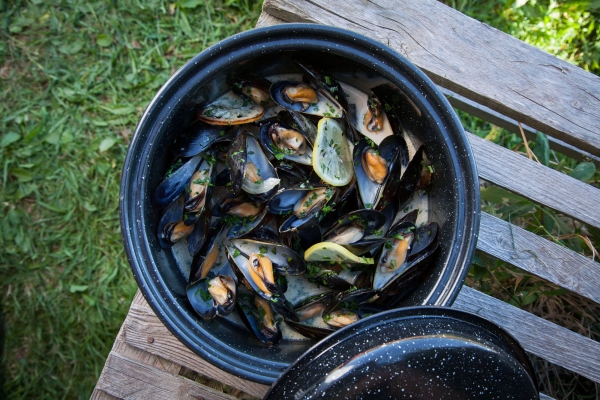Mussels Preparation
Published July 30, 2021 | Tourism PEI
Categories:
Culinary
Fresh mussels, cultured in the cool water surrounding Prince Edward Island, are one of North America's most popular seafoods. Cultured mussels grow in mesh stockings suspended from longlines (ropes) in the water. Prince Edward Island's pristine waters provide the ideal conditions for rapid growth. The cultured mussel is tender, plump and sweet with a higher meat yield than its wild counterpart.
How to Buy
Fresh cultured PEI mussels are wet and shiny with blackish-blue shells and measure two to three inches in length.
- When purchasing mussels in a mesh bag, check the tag for "Product of PEI" and the harvest date. If sold loose, ask your fishmonger about the harvest location.
- Check for any open shells by tapping. If the shells do not close when tapped, they should be discarded.
- Wild mussels are a dull bluish colour with white erosion marks, and usually have seaweeds or barnacles attached.
How to Store
- Fresh mussels in the shell should be stored in the coolest part of a refrigerator for 5 to 8 days.
- Keep moist by covering with a damp cloth or wet newspaper. Store in an air-tight container or water.
- The less mussels are disturbed, the longer they will remain alive; therefore, the time to clean them is just before cooking.
- Cooked mussels may be frozen by placing the shucked meats in plastic containers and covering them with a brine solution of 1 teaspoon (5 ml) salt to 1 cup (250 ml) water. Allow 1/2 inch (1 cm) head space for expansion during freezing. Mussels frozen in this state will store for 3-4 months. If mussels are to be frozen in the shell, they should first be blanched in boiling water for 20 seconds, then drained and packed in heavy plastic bags or plastic containers. Storage time for mussels frozen in the shell is approximately 2 months.
How to Prepare
- To prepare mussels for cooking, rinse the shells under cool running water. Remove the byssus threads (a bundle of brown fibres found between the two shells of the mussel) by cutting with scissors or pulling out with a quick tug.
- Mussels are traditionally prepared by steaming over medium heat for 5-7 minutes or until the shells open and the meat becomes loose from the shell. If you continue steaming, you will overcook the mussels, causing them to be tough and dry.
- Because fresh mussels contain liquid, which comes out during steaming, it is optional to add extra liquid.
- Add vegetables such as carrots, celery and/or onion for extra flavour.
- Don't be concerned by different colours of mussel meat: pale white meat indicates a male and a yellowish rust colour is a female.
- To prepare in a microwave, place mussels in a shallow pan, add 1/4 cup (50 ml) hot water and cook on high temperature for 4-5 minutes.
- If the mussels are several days old, you may need to add about 1/2 inch (1 cm) of liquid to the bottom of the pot.
How to Serve
Once the mussels have been steamed open, they are ready to eat. Serve as is or remove the meat to prepare as part of a dish.
- Mussels can be substituted in any recipe for clams or oysters.
- Mussel juice is delicious to drink hot and good mixed with some melted butter. It can also be chilled and mixed with tomato juice.
- Mussel juice can also be frozen to use as a chowder broth later.
Serving Size
- As an appetizer, allow 10-12 mussels per person (approximately 1/2 pound or 225 g).
- As a main course, allow 20-25 mussels per person (1 pound or 454 g).
- Approximately 20 to 25 cooked, shucked mussels measures 1 cup (250 ml).
Mussel Nutrition
PEI Mussels are a good source of vitamin C, which is rare among protein sources, as well as an excellent source of iron, zinc, selenium and antioxidants, while low in fat and cholesterol. A 3.5 oz (100 g) portion of mussel meat contains the following:
- 95 calories
- 14.4 g protein
- 2.2 g fat
- 88 mg. calcium
- 3.4 mg. iron
- 289 mg sodium



